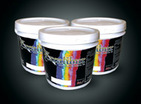Transitioning from plastisol- to water-based processes will require new routines and techniques, from the screenroom to the dryer. Here is a quick snapshot of some rules to live by as you make the switch:
Transitioning from plastisol- to water-based processes will require new routines and techniques, from the screenroom to the dryer. Here is a quick snapshot of some rules to live by as you make the switch:
Ink Department
• Because the pigment load of a water-based ink is much lower than plastisol, use an accurate scale when mixing colors;
• Keep inks covered in production and sealed when in storage to prevent evaporation;
• Shake pigment containers on a regular basis – monthly, at a minimum – especially with fluorescent pigments;
• Follow the manufacturer’s instructions when using additives such as retarders, penetrants, crosslinkers, softeners, thickeners, and thinners;
• And, label ink buckets to indicate which additives have been used to avoid confusion when using the inks later.
Screenroom
• Use lower mesh counts (110-156 threads per inch) for solid areas and underbases;
• Pay attention to the thread diameter and percentage of open area, not just the mesh count. Thinner (S) threads will provide optimal results;
• Properly clean mesh to avoid fisheyes and pinholes:
o Remove haze;
o Degrease;
o And dry thoroughly before coating;
• Use your scoop coater correctly to apply even emulsion coating:
o Use the dull edge of the scoop coater for mesh counts below 200 threads per inch;
o And above 200, use the sharp edge;
• In order to build good EOM, apply one coat of emulsion on the outer (shirt) side of the mesh and two coats on the squeegee/ink side;
• Dry thoroughly, print side down;
• Consider using a second face coating on the squeegee side to prolong screen life;
• Fully develop the stencil to prevent stencil breakdown from underexposure:
o Exposure calculators are recommended;
o And post-exposing the screen may also be advisable;
• Use emulsion hardeners to extend screen life on longer print runs:
o Allow screen to dry completely prior to applying the hardener;
• And screens must be dried thoroughly prior to production or the trapped moisture will lead to premature breakdown on press.
On Press
• Keep a spray bottle of water at the press and use as needed to prevent ink from drying in the screen;
• Minimize air movement across the inked screens and ensure that fans are not blowing across them;
• Set the cycle to print and then flood, keeping ink over the image area at all times;
• Decrease the floodbar pressure to allow for more ink to flow across the image area;
• Squeegees:
o Use medium to soft squeegees (55-65 durometer) or triple durometer (55/90/55);
o Set the press with 40-50 psi pressure and medium squeegee speed to ensure optimal opacity and sharpness;
o Use slightly more angle (approximately 30-35 degrees) than you are accustomed to with plastisol;
o Minimize squeegee pressure;
o And round or dull the corners of the squeegee to reduce abrasion;
• Use only a small amount of ink during registration to avoid any potential drying in the screen;
• Set the off-contact at 3-4 mm to allow the squeegee to better clear the mesh and produce sharper prints;
• Order the screens in the job from the smallest print area to the largest, and print the highlight white last;
• Preheat the pallets to 160 F prior to the production run;
• And leave an empty print station after flashing as a cool-down station, if possible.
Advertisement
Curing
• Follow the manufacturer’s recommended dwell time and dryer temperature settings, remembering that all water must be removed from the ink film before the binders can bond to the fabric and become washfast;
• Be sure that air circulation in the dryer is adequate to fully cure the printed ink film;
• Check and adjust the dryers regularly;
• And monitor changes in relative humidity, which can affect the required drying time as garments absorb moisture from the air.
Discharge Printing
• Use only 100-percent cotton garments that use reactive dyes;
• Avoid garments that have been re-dyed;
• Royals, kelly green, gold, and purples generally do not discharge well;
• A garment’s ability to discharge can vary across dye lots;
• The discharge effect will occur only after the water is fully evacuated from the printed ink film;
• Discharge inks colors will vary across different color garments;
• Completely stir in the activator, wait 10 minutes, and then re-stir to ensure it is fully dissolved;
• Prior to printing, gently remix the ink;
• For best results, print wet on wet without the use of flash units;
• And use a print sequence of the smallest print area to the largest, with the highlight white always last.
See also:
Mastering Water-Based Inks
The Challenges of Water-Based Inks
Water-Based Ink Options


 Art, Ad, or Alchemy1 month ago
Art, Ad, or Alchemy1 month ago
 Case Studies1 month ago
Case Studies1 month ago
 Andy MacDougall1 month ago
Andy MacDougall1 month ago
 Columns2 weeks ago
Columns2 weeks ago
 Editor's Note2 weeks ago
Editor's Note2 weeks ago
 Thomas Trimingham2 months ago
Thomas Trimingham2 months ago
 Marshall Atkinson2 weeks ago
Marshall Atkinson2 weeks ago
 News & Trends1 month ago
News & Trends1 month ago















